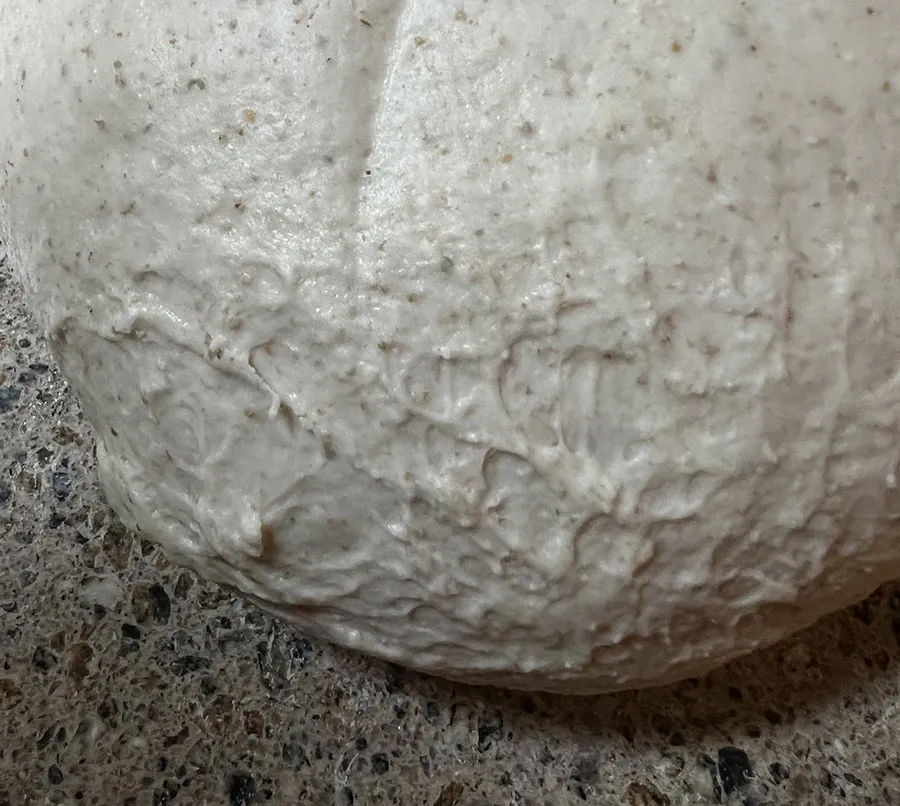
BACKGROUND
My husband is not a fan of sourdough, although everyone else in my family loves the stuff. He won’t eat any bread if he detects the merest hint of sourdough flavor. When I happened upon Swiss Farmhouse Bread in Jeffrey Hamelman’s Bread, which in Mr Hamelman’s words is characterized by “a complete absence of acidity,” I was curious. The bread was leavened by water in which yeasty raisins had been soaking and that was my entree into the world of yeast water. Working with YW made me wonder if it could be used in conventional sourdough breads and what its effects might be. Wouldn’t it be nice if a flavor profile emerged that could be a favorite (if not the favorite) of all the people I bake for? Hey, a girl can dream, can’t she?
YW is interesting to me as a potential means to that end, but two things about it concern me:
1) The Swiss Farmhouse crumb was a little bland without the flavor enhancement provided by fruit and nuts. I’m searching for something other than the familiar sourdough flavor profiles, but I would still like a flavorful bread.
2) I’ve found the rise times of YW to be wildly unpredictable, which makes me hesitant to use it except when I happen to have a few days when nothing else is planned. Once my YW matures and I get in the habit of keeping YW levains under refrigeration for later use, I hope this will change.
It seemed reasonable to start this project with my basic SD bake, Vermont Sourdough (also a Hamelman formula). After again checking with the YW gurus here on TFL, it was pretty clear that every baker has their own way of incorporating YW into conventional SD loaves and that pretty much any of them could be expected to work.
PROCESS
Yeast Water
The first order of business was to give the YW some TLC. It was removed from the refrigerator the day before the bake and the liquid poured off into a clean jar. I was careful to pour off as little of the bottom sludge as possible, which I understood might contain a fair percentage of dead yeasts that could add glutathione to the dough, an eventuality I wished to avoid. There seems to be some anecdotal evidence contradicting that outcome, but I didn’t see any point in taking the risk, so I declared the new jar a Sludge-Free Zone. Diced organic apple was added to the jar and the pH was measured. It tested at 3.73 despite the fact that it had been holding steady at 3.43 – 3.46 for its first three weeks of life. The jump to 3.73 seemed like a large-ish decrease in acidity that I was unable to account for. As long as the pH was below 4.0, I believed it was safe to use, but it seemed to be headed in the wrong direction, so I dropped in the teeny-tiniest pinch of Ascorbic acid (probably about a tenth or two of a gram) and left those little yeasties alone to do their overnight thing. Since the YW was increasingly sluggish the last couple bakes, I hoped these measures would yield a yeastier, more active YW.
Preferments
Based on input from several TFL members and my own wish to use the same amount of prefermented flour called for in the original formula, I decided to make two half-size levains, the first half a standard SD and the second half made from YW. The SD levain for this bread is a liquid levain of 120% hydration. My preference was not to change the hydration, but I remembered reading an assertion that YW levains are better on the stiff side, so at the last second I decided to make the YW levain at 70% hydration to match the final dough. The final dough water was adjusted to accommodate this change. For the record, bottled mineral water was used in the final dough. I usually use filtered tap water.
I decided to build both levains just before bedtime and hope that the SD levain didn't mature first. Fortunately they seemed to track reasonably well and both levains were ready for use around the same time. The SD had receded only very slightly from its peak when it was mixed into the dough.
Final Dough
The autolyse was mixed in my Ankarsrum on the lowest speed because I intended to do the final mix that way, so why not. The Ank is very gentle on low settings. The dough was still surprisingly ragged 30 minutes into the autolyse, but had improved by the 45 minute mark. It had an unusual feel to it, but I proceeded with the mix and that’s when things got really weird. I’m hard-pressed to describe the dough’s texture. It felt soft but… I don’t know… dry? tight? Those aren’t the right descriptors, but they’re the best ones I can come up with. I added 10-15g water in small increments in the hope of improving the texture. The additional water helped the dough feel somewhat better, but it did not feel like the gluten was developing well at all. The surface of the dough was beginning to appear pock-marked and after 7 minutes of mixing about 3/4 of the way up the Ankarsrum dial (the sixth “box”), the surface of the dough started pulling and breaking. I have not encountered this before and wondered if it might be the affect of glutathione. I have no familiarity with it and don’t know.
The Jiffy Pop Moment
Instinctively, I pulled the dough from the mixer bowl. It was quite sticky but not unmanageable with wet hands. I folded the dough but that just made it tear. I don’t know why I thought to try French folds when regular folds didn’t work, but for some reason they did seem to have a positive effect – until they didn't. Just when I was about to stop, the top surface of the dough split open like Jiffy Pop revealing layers of folded dough inside. I wish I’d thought to photograph it but in the moment my only thoughts were geared toward salvaging the dough if possible. I quickly folded the hole closed and did another FF. It seemed alright, so I did another and then another until the dough was largely smoothed out. Not wanting to bring on the Jiffy Pop Effect again, I stopped the moment most of dough’s surface looked smooth. I’d guesstimate there were about 40 or 50 FFs in total.
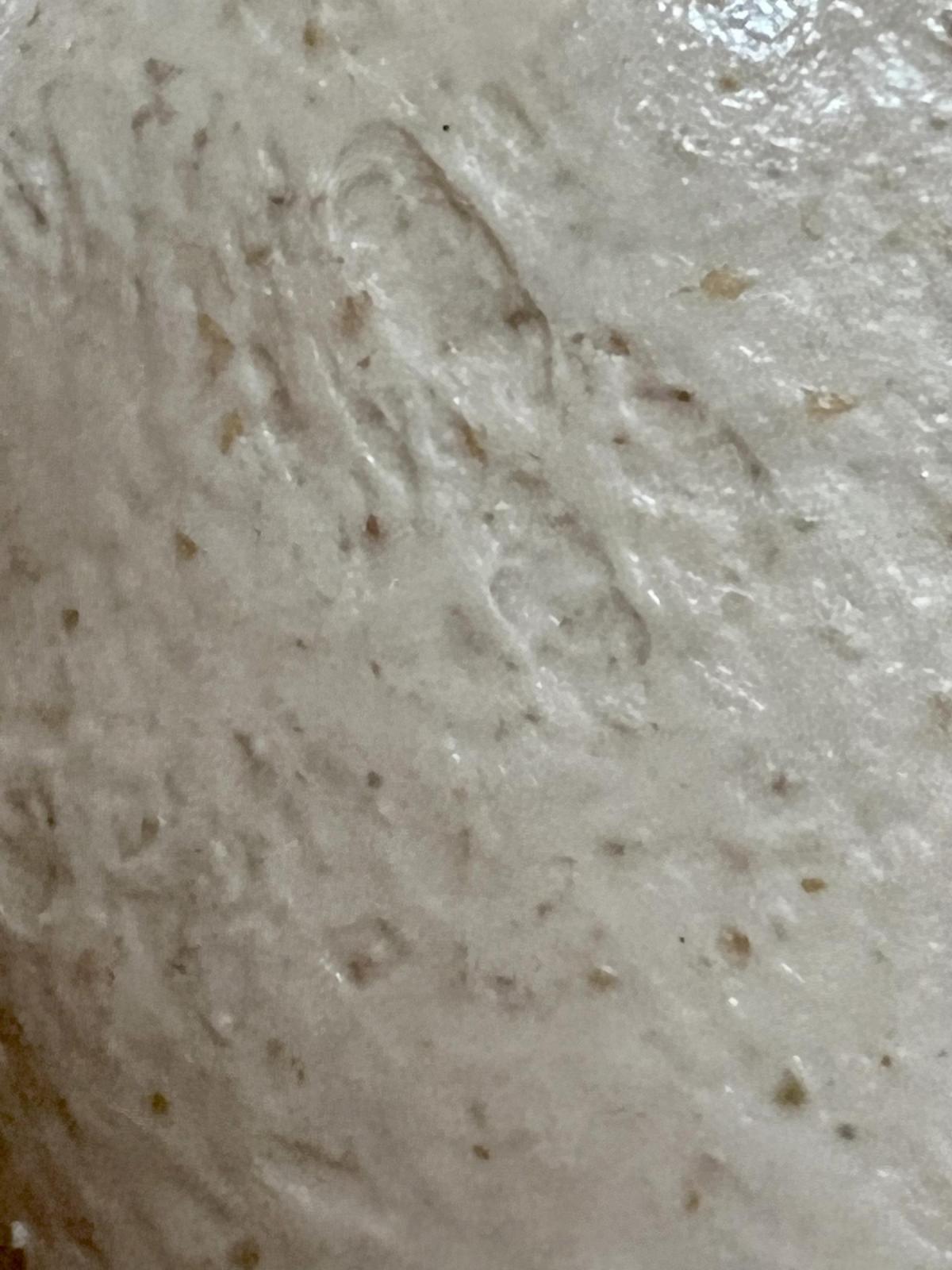
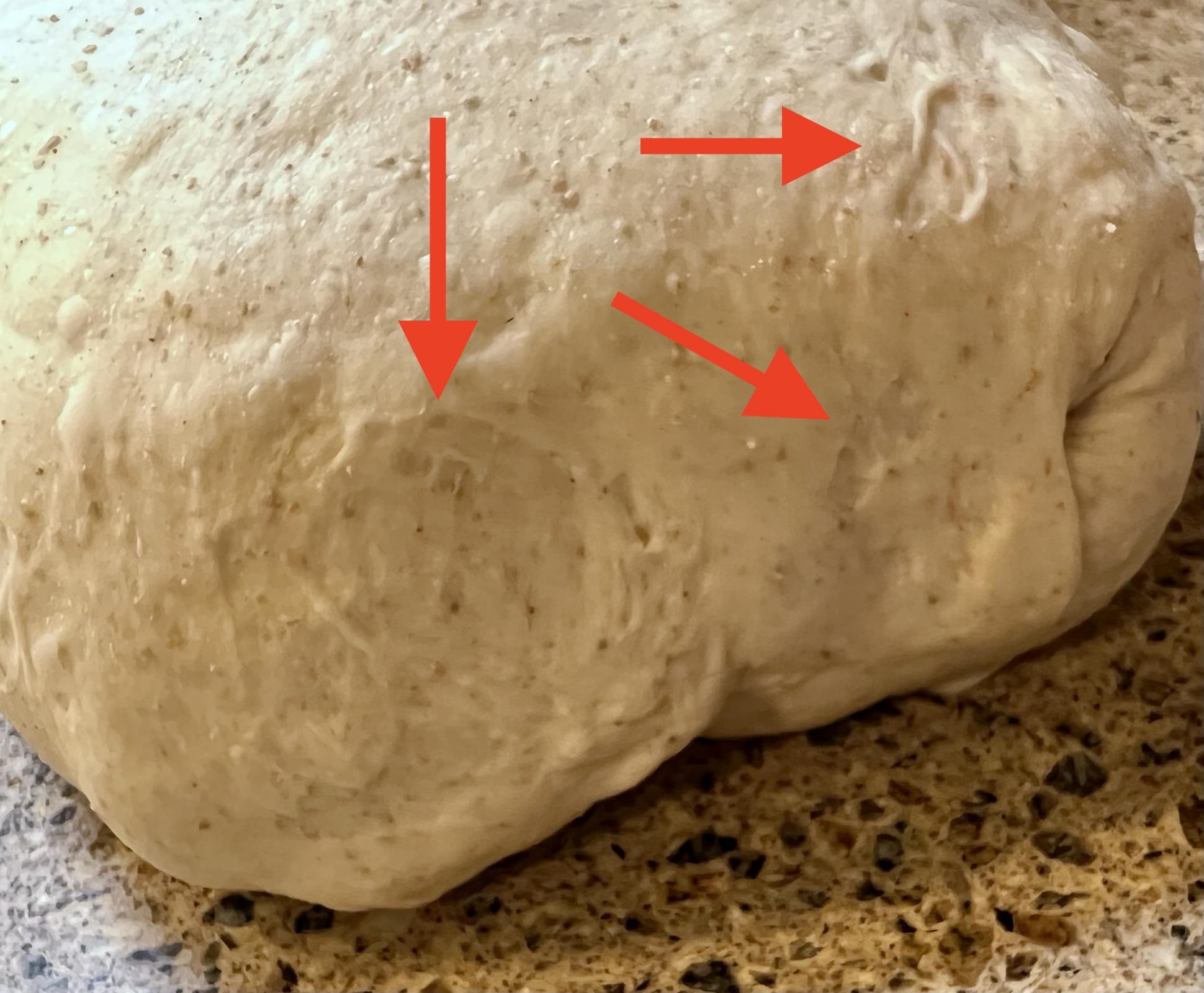
Mostly smooth, but there are still pock marks along the edges. I do wish I had photographed the dough at its worst, but honestly, there was work to be done.
At the end of the mix, the dough temp was 76.3°F so at least that was on target, even if nothing else was.
Bulk Fermentation
The dough was slightly risen after 90 minutes. It was more extensible after resting but still prone to tearing so there was no stretching, only folding. Pock marks like the ones in the photos above were apparent where the dough folded. Afterwards, the dough continued to rise but felt dense and heavy. Even when it had doubled in volume, it looked and felt leaden. I don’t typically let my doughs double during bulk and, under the circumstances, I was afraid of degradation so I shaped the loaves. Maybe I should have done so sooner. Too many mixed signals to be sure of anything.
Shape & Bake
After a preshape and 15 minute bench rest, the dough was molded more so than folded into shape to avoid tearing. The final proof progressed quickly and looked sufficiently risen after about 60 minutes. On feeling the dough, it still lacked that certain lightness that tells you it’s ready, so I let it go another 20 minutes until one of the loaves felt acceptably aerated. I was still concerned about gluten degradation, so that loaf was sprayed with water and, since it seemed sturdy despite its propensity for pulling and tearing, I scored it but only very shallowly. It stood up well to the slash. The dough was loaded into the preheated Fourneau Grande and the hatch closed. Silent prayers were said.
When Loaf #1 emerged from the oven, it exhibited great oven spring and a nice blistered crust. There was no ear; the dough filled in the bloom area and leveled out. I thought this was most likely due to the shallow scoring, so I focused on making a deeper cut into the second loaf. Unfortunately, I didn’t angle the blade very much. Who in that situation can resist the urge to commit the cardinal sin of re-scoring even though you know its impossible to hit the exact same spot? Not me. The result is the second loaf has a somewhat better ear and bloom but bears the scars of botched surgery.
Grand Opening
I'm going to bury the lede here and begin by saying the flavor was good, and the best part was that my husband enjoyed it. That was a win right there. Unfortunately, the crumb was a different story. Despite the good oven spring, the loaf was verrry heavy – not unexpected given the dough quality. You know that old trick question about which weighs more, a ton a feathers or a ton of bricks? The correct answer is a pound of this bread.
The bread looks better in the photos below than it turned out to be in real life. At the same, it wasn’t terrible. Given the bizarre dough quality, I was not expecting an edible bread. And, truthfully, the eating quality is not great… but it’s not bad either and makes, like many substandard loaves, decent toast.
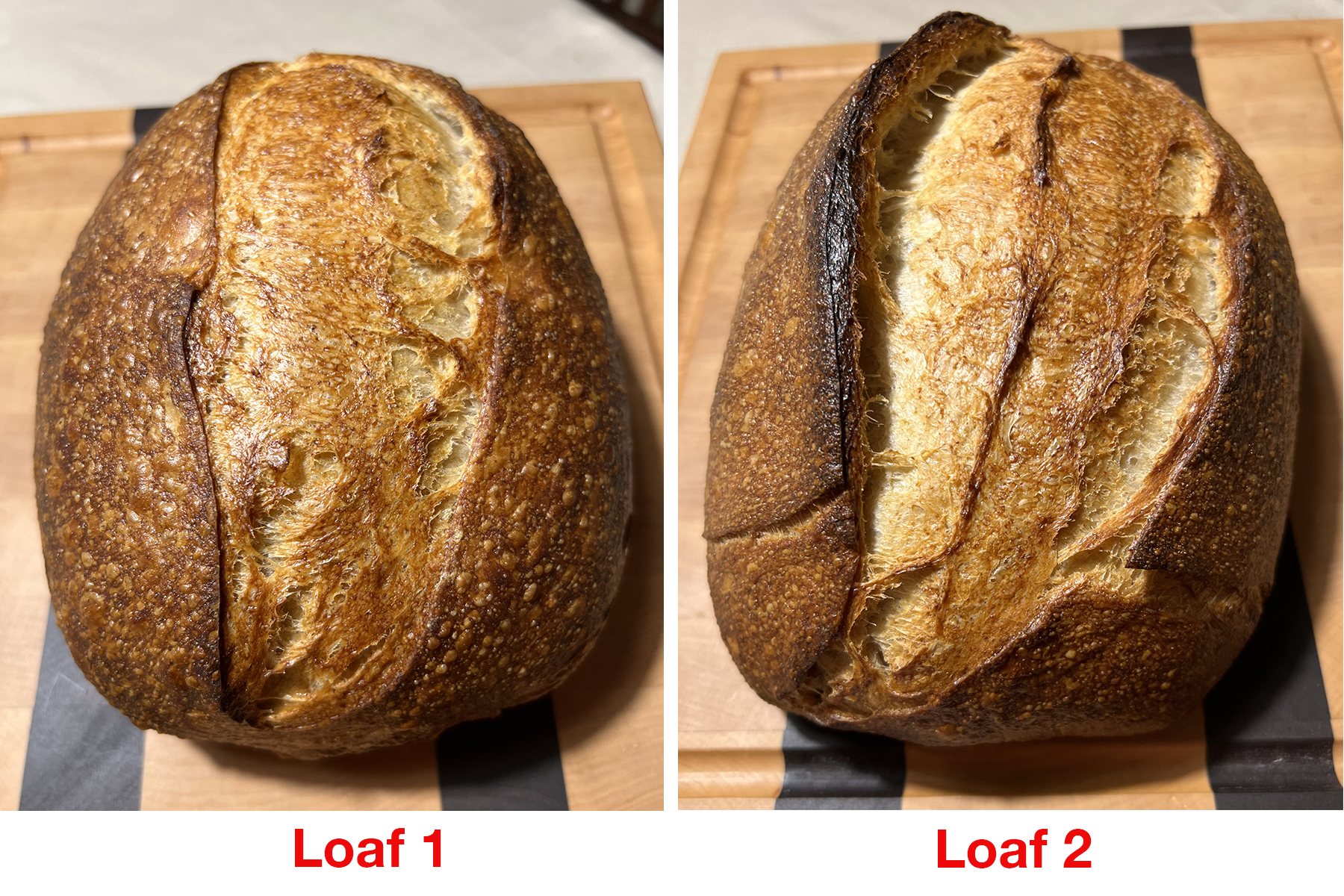
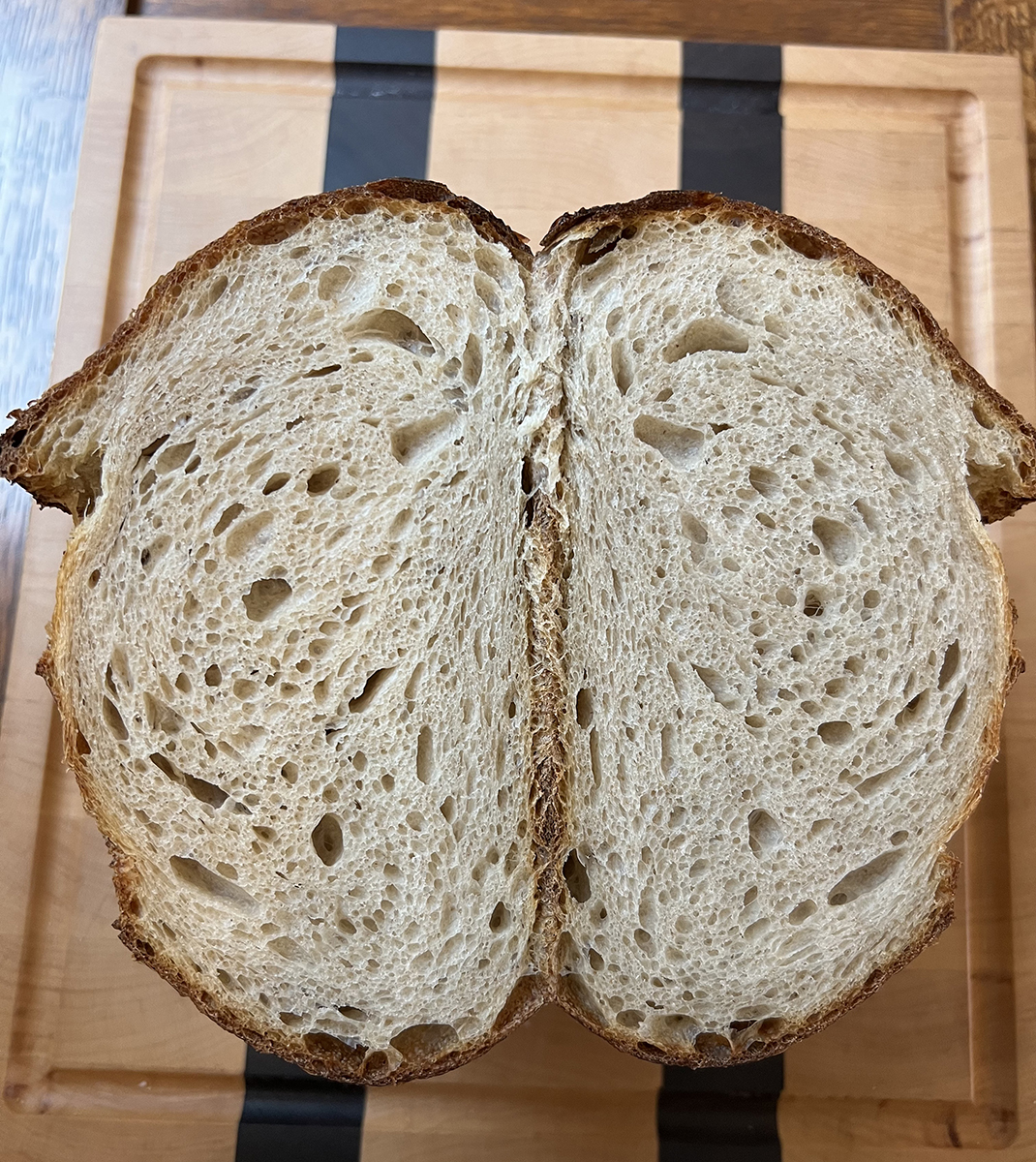
ANALYSIS – NO ANSWERS, ONLY QUESTIONS
So what happened with this dough? I assume the fault was floating in my jar of YW, so I made a fresh batch inoculated by a spoonful drawn from the old jar. This is the first time in the 4 weeks since it was first made that the water was completely changed. I feared doing so might dilute the yeast population in a young culture, but in light of the poor dough development, it seemed the prudent thing to do. The new YW spent the night in the proofer at the low setting of 75°F (the overnight temp inside the box was probably closer to 70°F). Once it looks active and the pH dips below 4.0, it will be refrigerated and given a few more days to develop.
Meanwhile, another YW levain (second build) rests in the refrigerator. I mixed extra to have on hand for SD-YW Test Bake #2, but now I think I will toss it and make a new levain when the new YW is ready.
TO BE CONTINUED
- Another Girl's Blog
- Log in or register to post comments
AG, first…. I’ll take your word that it not good, but those loaves look great to me! 😁
I’ve done quite a few bakes that combine SD and YW with Vermont SD. I stick with Mr. Hamelman’s target of 125% hydration and all of it coming from YW. I then cut the starter inoculation in half. Same fermentation time and temperature. For the SD starter, I do a refresh a few hours before the levain build and grab the starter just before or at peak to keep the acidity down.
Good luck!
Thanks so much, HeiHei. Interesting that you mentioned acidity. I've been searching TFL for possible reasons why this dough was so weird and found this: Debra Wink commented about having had a YW dough with a cottage cheese look that went away during bulk. There's not enough detail to know whether that dough was the same as mine but it's possible. Michael Wilson replied that coagulation might have been to blame and indicated that it could be caused by too much acidity. I will look further into coagulation and see what I can learn, but I'm now wondering if I shot myself in the foot by adding that tiny pinch of AA to a YW that was already at an acceptable pH.
Since you have experience with using YW in Vermont SD, may I ask what type of rise you've had in bulk? This dough doubled but still seemed heavy. It doesn't make sense to say it, but that's what I experienced. I felt it needed more time to keep expanding, but the way the dough broke up during the mix made me afraid to let it continue. Plus, I usually end bulk way before the dough doubles. But they usually feel well aerated by then. In this case, the dough didn't feel well aerated even thought it had doubled. Despite appearances, the final bread is similarly heavy feeling. I almost didn't post crumb photos for that reason. This bake was just... weird.
Thanks for posting your method for incorporating YW into this formula. I'll use it for Test Bake #2. It will eliminate the problem of coordinating the timing of two levains so I can catch the SD levain slightly before peak instead of slightly after.
I would agree with Don’s comment below about the dough being “tight” sometimes with YW. For gluten development, I almost always use this method(Bowl Kneading) or I do FF, but like you mentioned, I usually do 25-50 FF with 5 minute rests (3-4 sets). I usually only do FF with 70+% hydration. When doing the bowl kneading, I stop as soon as I see the little side tears that you had in your pictures.
For bulk, I let the dough go to at least 80% with folds every 30 mins if the dough feels loose or every 45-60 minutes if it feels tight.
Here's a Vermont SD type loaf. I mix and match sometimes depending on what strikes me (I experiment a lot :-) ). In this one, I used 120% hydration and 50:50 water:YW. I've also used 125% hydration and 100% YW. Sometimes I go 5% with the SD starter inoculation (in the levain) and sometimes 10% (like this one). You can mix and match to suit your taste.
Good luck!
Duplicate
AG it’s hard to believe that this loaf isn’t great. The crust and bloom look really great as does the crumb. Sorry I can’t be of much help since I’ve played so little with yeast water and instead of bread I’m now using mine to make raspberry vinegar. The win certainly is that your husband likes the bread and that it is instagramable.
Benny
Seriously, it looks very, very good
The few times I have used YW in the preferment and then in dough it felt tight and stiff and not conducive to folding. I have seen the word Bucky used to describe it when it is dry and stiff like that. However it always seemed to work out fine in the end.
Nice write up AG and good looking bread. Chalk one up in the win column.
Don
Thanks, everyone, for your generous comments. I have to agree that the final bread looks good. This is a case where it probably would have been better not to post the crumb shots, haha! I probably should have posted a question in the forum including only the dough photos.
There is undoubtedly some component of needing to acclimate myself to differences in YW doughs, but this dough was dramatically different and I can't believe it was in any way normal. In retrospect, I wish I'd had the presence of mind to wipe off my hands and grab the camera when the dough burst open during the FFs. Or even before that when it was "dimpling" in the mixer. Unfortunately, my photos don't do a great job of illustrating exactly how unusual the dough properties were. I need to be better about capturing images for diagnostic reasons. Meantime, I'll keep snooping around on TFL to see what I can find.
Based on Don's and HeiHei's comments about tightness and occasional tearing, maybe machine mixing was too much for this dough – especially if it was already on the acidic side. The Ankarsrum is generally pretty gentle and I don't worry about over-mixing, but maybe it's best avoided with YW doughs. Thanks very much for your comments and for giving me some things to adjust next time out.
Maybe it’s not relevant but your rye flour looks like a coarse grind. Could it be related to the tearing? I think you could increase the hydration to give your dough some more extensibility. I doubt your mixer is not suitable for developing YW dough but it probably lends itself to a more uniform less irregular crumb.
I have been following your thread and it prompted me to check on my several weeks old YW in the back of the fridge. The raisins had sunk to the bottom so I added a tsp of sugar, shook it and left it out on the counter. The raisins floated again almost immediately so I used it the next day for about 1/3 of the water in the final dough of a SD country bread with 18% spelt flour. The rest was KA all purpose flour all mixed by hand. The dough was 75% hydration and very loose from the start and never really held much tension like spelt is known for. The interesting part was the bulk ferment was complete an hour or more earlier than normal which sometimes also happens to me with spelt but the YW seemed to speed things up even more.
The crumb was decent except for the large bubble I sometimes get from folding it in half when it goes in the basket.
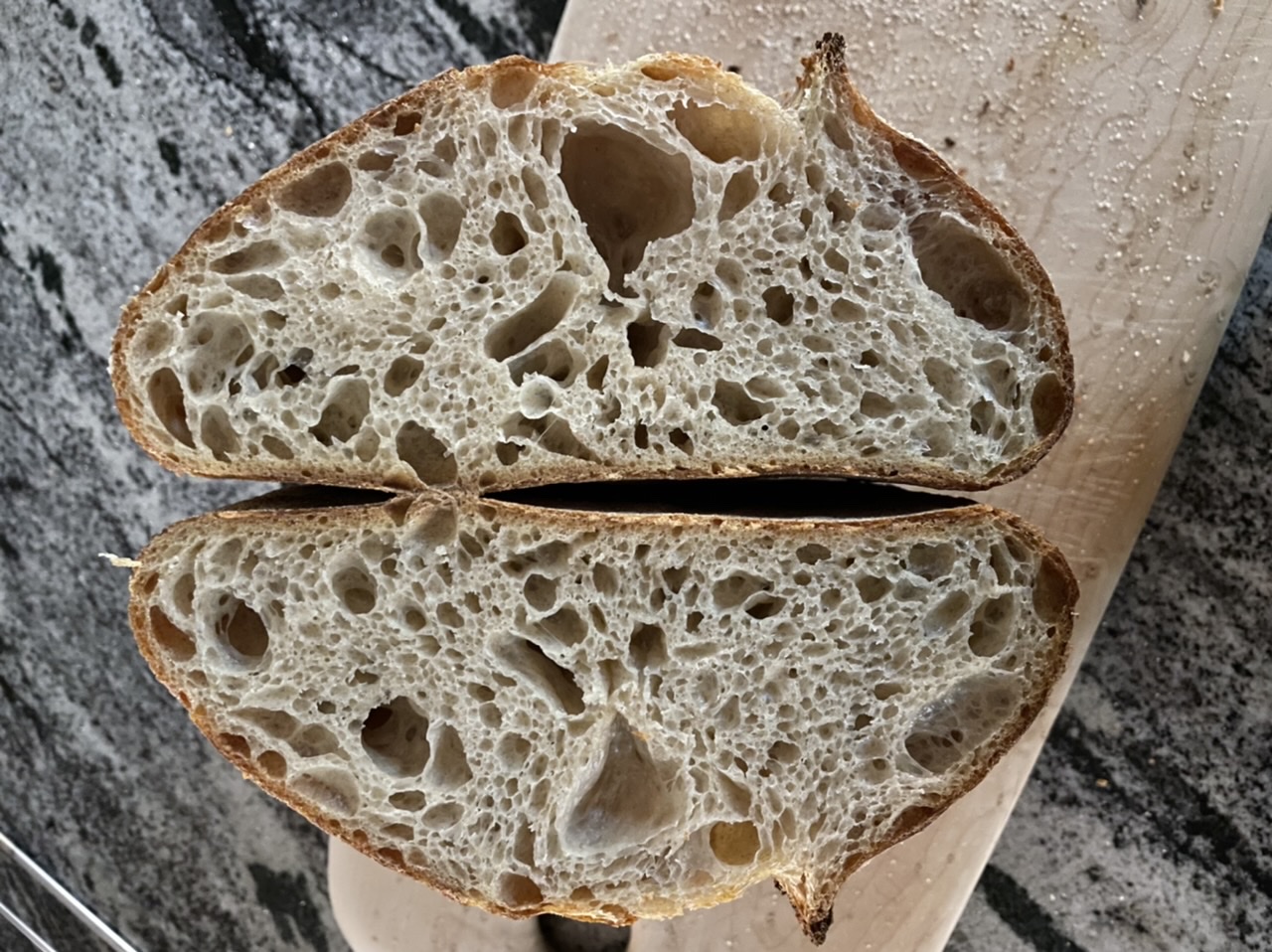
Sorry for the auto rotate.
The flavor was milder than a full on SD but not as hollow as a YW bread. Thanks for the inspiration.
Don
That's a great looking loaf, especially for having a big scoop of whole grain spelt in it. You really nailed the fermentation. It's great that you just took a YW out of the fridge after 3 weeks and knocked that out of the park. Hopefully mine will be that strong soon.
"The flavor was milder than a full on SD but not as hollow as a YW bread." – Very encouraging, that’s what I’m going for. Flavorwise, I think mine was in the ballpark.
Good eye on the rye flour. It's KAF Organic Pumpernickel and it is a coarse grind. I'd be surprised if it was more than indirectly related to the weird rheological problems because I've been using it in my Vermont SD for long time. Granted, I haven't used it with YW before. Ryes tend to be more acidic in general, so that and my starter (100% whole rye, same flour) probably contributed more acid to the dough. That assumes excess acid caused the problem and I don't know that it did. I'm not very knowledgeable about this stuff. I'm reading threads on thiols and coagulation but so far I can't tell if the difficulties I had are related to either, neither, or both.
Again, kudos on a really nice bake!
As I'm now seeing your bread on my laptop (as opposed to the cell phone), I'm super impressed by your crust!! Super thin and crisp. Well done!
I was pretty happy with it for my first hybrid loaf. It I wasn’t very clear I wanted to be specific that I used a 100gr of sourdough levain in this bread along with 125ml of YW in the final dough. It definitely fermented faster than using either alone. Next time I will swap out the spelt for wheat and hope to get a little more strength.
Don
I'd think anyone should be happy with that, it looks fabulous. I'm going to make it even though I sure can't make it better. It will have to wait a couple weeks because I made a new batch of yeast water after the last batch went rogue. I'm going to give it a few weeks in the back of the fridge to get all yeastified. I hope the next generation will be better behaved than their parents were.
Hi AG! Thanks for posting this...lots of great info and photos. I've also been very intrigued by all the posts related to yeast water and wanted to give it a try.
I was able to create one last week with a mix of dried fruit, built an active levain and proceeded to bake an everyday loaf with it. I mistakenly used 100% YW for all the water required in the dough though (in addition to the YW levain), but I've seen some posts saying this was ok. I think I will only use 50% YW next time as, as you described in your post, the dough behaved and felt weird. I had similar lumpiness and some minor tearing during shaping, and strangely, the dough did not want to stick to itself...had a tough time pinching the ends together before placing in the banneton. It felt kind of dense during shaping so I let if proof another hour at RT before the over night cold rest.
I didn't get the lovely crumb that you did either. It wasn't dense, per se, but neither was it light and airy...somewhere in the middle. The texture was super soft, but no real aromas to speak of. The crust was a little lighter but I found the loaf was browning quicker than usual, so the overall bake time was reduced by nearly 10 minutes, so maybe the light crust was due to the reduced time in the oven. The ear wasn't as pronounced as usual either. All in all, a strange bake too, similar to what you described. I'm going to give it another try this weekend, but with reduced YW in the dough. Fingers crossed, because the YW does seem to be a slightly easier starter to work with and maintain (at least in my limited experience).
I did get a great result using YW in my pizza dough recipe though...fantastic texture and cornicione. So, I'm a fan at least in that application.
Thanks for posting your adventures...it's good to know my first experience with YW wasn't a unique one. I hope you will keep us posted on your ongoing YW adventures!
Hi Naturaleigh. Fifty percent is a reasonable starting point; in fact, I made a test loaf replacing 50% of the total water with YW yesterday. I was convinced my YW was too acidic, so I made a new one. To see if it was ready, I made a small 400g test loaf, replacing half the water in the levain and final doughs with YW. The SD inoculation was also cut in half (and to be clear on that, it was the same size levain but with half the starter called for in the original formula – Thanks, HeiHei, for the suggestion!). It took 9 hours for the levain to double, so the YW wasn't as strong as it could have been, but once it got going it really got going. The bulk phase was fast and in the end it over-proofed. It was just a test loaf, so I didn't have a lot invested in it, but it taught me that the new YW needs more time and that 50% of total water is probably still too much. Next time, I'll probably use only a splash of YW in the final dough to see if it slows down the bulk fermentation. Additionally, I found the crumb to be a little soft and I wouldn't mind restoring some of the characteristic sourdough chew.
I hope you do another YW bake soon and post your experience. I saw your YW pizza and it really made me hungry so we ended up ordering one. It was good, but yours looked better!
Thanks for posting more info, AG! SUPER helpful since I was planning on building another dough on Friday. Not sure if I will do a combo levain (1/2 SD and 1/2 YW) or just another straight YW levain with a significantly reduced YW addition for some of the water in the dough...we'll see how that goes. I will definitely let you know. I'm tempted to stick with just YW rather than introducing another variable (part SD levain) so that I can judge the outcome best.
Thanks too for the nice comments on the pizza! I was very happy with how that YW bake turned out!